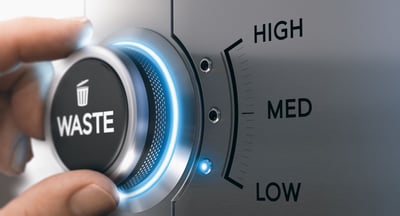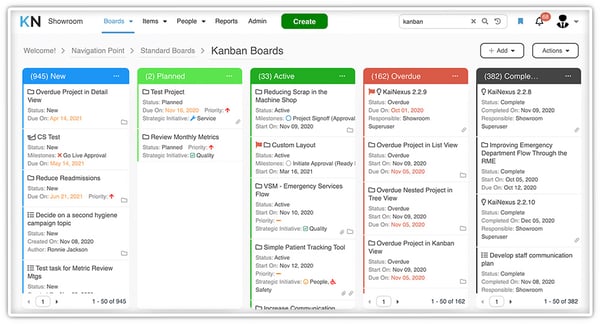 Lean organizations look to minimize eight types of waste to create a flawless flow of value to the customer. In a perfect world, no resources are used until necessary, and every task contributes something for which customers are happy to pay.
Lean organizations look to minimize eight types of waste to create a flawless flow of value to the customer. In a perfect world, no resources are used until necessary, and every task contributes something for which customers are happy to pay.
In reality, achieving this is much more challenging than wanting it. That’s why Lean tools and techniques have been created to help leaders embark on this journey. Using software designed to support this type of positive change is one way to ensure success.
The Principles of Lean
Before we dive into the categories of waste used by Lean organizations, it is helpful to revisit lean principles that drive the desire to reduce waste. They are:
Value: Lean thinking is centered on bringing value to the customer. Value is defined as anything for which a customer will gladly pay. Value is only determined by the customer. Anything that does not produce value is waste.
The Value Stream: The production of goods and services involves a series of processes known as the value stream. The best way to find and eliminate waste is to map the value stream. Any steps in production that do not produce value should be minimized or eliminated.
Flow: The Lean principle of flow is about making sure that value flows to the customer unimpeded. Interruptions inflow cause waste.
Pull: The lean idea of pull is that nothing is created before it is needed. One part of the production process pulls in work-in-progress or raw materials from the upstream operation when and only when it is required.
Perfection: Lean leaders believe that each task, process, or operation can constantly be improved. When one improvement cycle is completed, another begins. Improvement is continuous, performed by every employee, and valued as part of the culture. While perfection is always elusive, Lean organizations never stop trying to get there.
With these principles in mind, it is easy to see why eliminating waste is an essential goal of Lean organizations.
The Eight Wastes of Lean
The Lean methodology calls out 8 specific types of waste. This is useful because some types of waste are less obvious and might not be top of mind when your team starts to think about waste reduction.
They are:
- Transport: Of course, it is necessary to move products, raw materials, and work in progress from one place to another in the course of production, but every time something is moved, you introduce an opportunity for damage, loss, or delay. Transporting things also contributes to expenses that may or may not value the customer.
- Inventory: Materials or finished products that are not immediately required for production or customer demand unnecessarily tie up capital and use space. Just-in-time production was developed to eliminate this problem, but excess inventory isn’t just a problem for manufacturers. For example, extra inventory might be lumber, office supplies, medical equipment, or textbooks.
- Movement: The waste of movement is similar to the waste of transport, but it is about the unnecessary movement of people and equipment, rather than raw materials and products. Poorly designed workspaces often cause excess movement. It also includes business travel that isn’t really necessary.
- Waiting: In Lean, the waste of waiting most often refers to a function that cannot process work because upstream inputs are not available. This problem isn’t limited to manufacturing. It occurs in software companies, construction, medical offices, and most other business sectors.
- Overproduction: Overproduction happens when more product is produced than needed. This type of waste is particularly troublesome because, in addition to the waste of effort and resources that go into creating the product, the result is often wasted inventory. Overproduction is a double whammy.
- Over-processing: Over-processing refers to extra features or processes that the customer does not value. Unnecessary diagnostic tests, software features that are rarely used, excessive packaging, and overly complicated product instructions are all examples of over-processing.
- Defects: Defects are perhaps the easiest type of waste to spot. Reprocessing, repairing, or restarting processes adds no value and eats up precious resources.
- Human Potential: The waste of human potential hasn’t always been recognized in Lean circles, but it can make all of the difference in securing a competitive advantage for an organization. The people who are the closest to your products and customers have brilliant ideas for how to innovate and improve processes. Organizations that ignore that resource are
committing perhaps the most regrettable form of waste of all. Whether you are a manufacturing plant with front-line assembly workers or running a software development team, there is always room to engage employees in a way that allows them to do their best work and thrive.
Applying Technology to the Waste Reduction Challenge
Lean software can give a huge lift up to organizations dedicated to finding and eliminating all forms of waste. Here’s how it helps:
Collect Opportunities for Improvement
The first step in minimizing waste is identifying where and when it happens. Lean software makes it easy for everyone who notices an opportunity for improvement to document and report it. Users put all opportunities into one central platform, giving managers a seamless way to prioritize them for action. Ideally, the software works on any device, allowing workers to document ideas for improvement from anywhere at any time.

Support Cross-Functional Collaboration
Commonly, the points in a process where different functions intersect are where waste occurs. Typically, friction in the hand-off causes waiting, wasted motion, and unneeded movement. Lean software helps by getting all departments on one platform to manage improvement projects. The approach improves communication, makes decision-making easier, and helps sustain momentum.
Streamline Workflow
Spreadsheets and email are great for many things but not very effective against the eight wastes of Lean. What’s better is a system with built-in alerts and notifications to let the right people know when action is necessary. As a result, project managers gain real-time visibility into improvement projects and new opportunities to jump in and resolve any challenges that arise.
Addressing the wastes of lean using software starts by breaking down each opportunity into a manageable project with a clear owner, defined objectives, and individual tasks. The PDSA (Plan, Do, Study, Adjust) improvement cycle is often used to structure the improvement.
Visualize Pull and Flow
One common Lean tool that is enhanced by software is the Kanban board. A kanban board visualizes work at various stages of a process using cards to represent each bit of work-in-progress. The cards move from left to right to indicate progress and help align the teams performing the work. They can be as simple or complex as the process requires. While kanban boards began as a physical artifact, digital kanban boards make it possible to manage pull and flow from any location, store information about each project and give leaders insight into all of the work-in-progress in the organization.
Measure Results
Identifying and quantifying results is the key to a successful Lean initiative. When you can talk about how waste reduction has impacted the organization regarding cost savings, time to market, quality outcomes, and customer satisfaction, you’ll get the kind of support and engagement that can lead to a snowball effect. In addition, lean software makes data collection and analysis painless.
There is no silver bullet for eliminating the eight wastes of Lean. But software makes it easier to identify, resolve, and quantify waste. Implementing an improvement-based solution is an intelligent way to deliver as much value as possible.

![[Watch Now] How to Leverage Lean for Long-Term Success](https://no-cache.hubspot.com/cta/default/326641/eb5ac7b8-b040-48b7-810e-1589561ffff9.png)


Add a Comment